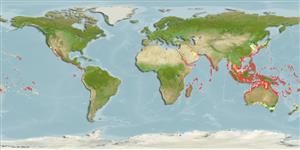Common names from other countries
Environment: milieu / climate zone / depth range / distribution range
Ecologia
; intervalo de profundidade 0 - 50 m (Ref. 349). Tropical
Indo-Pacific.
Length at first maturity / Tamanho / Peso / Idade
Maturity: Lm ? range ? - ? cm Max length : 33.0 cm SHL macho/indeterminado; (Ref. 349); common length : 20.0 cm SHL macho/indeterminado; (Ref. 349)
This large and common species is actively collected in many parts of the Indo-West Pacific realm (Ref. 349). Maximum depth from Ref. 101003. Often on clean coarse sand and rubble bottoms in which large individuals partially bury themselves. Preys on bivalves and other gastropods (Ref. 349). Damages pearl oyster beds (Ref. 799).
Life cycle and mating behavior
Maturidade | Reprodução | Desova | Ovos | Fecundidade | Larvas
This species is a non-broadcast spawner. Life cycle does not include trocophore stage. Also Ref. 833.
Poutiers, J.M. 1998. (Ref. 349)
Status na Lista Vermelha da IUCN (Ref. 130435)
Status no CITES (Ref. 108899)
Not Evaluated
Not Evaluated
Perigo para os humanos
Harmless
Uso pelos humanos
| FishSource |
Ferramentas
Fontes da internet
Estimates based on models
Preferred temperature
(Ref.
115969): 22.8 - 29.1, mean 28 (based on 1524 cells).
Vulnerabilidade
Low vulnerability (23 of 100).
Categoria de preço
Unknown.
